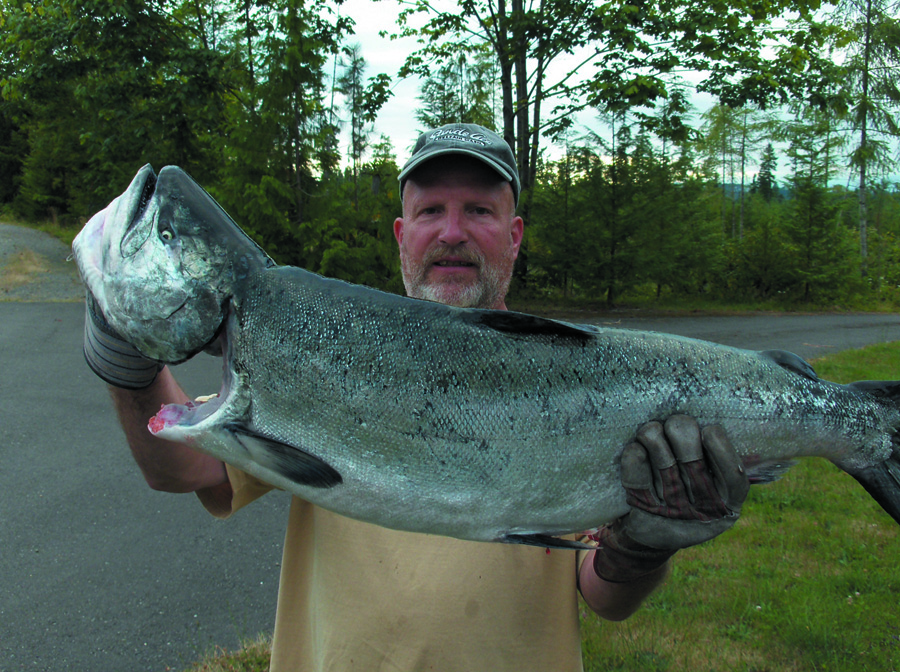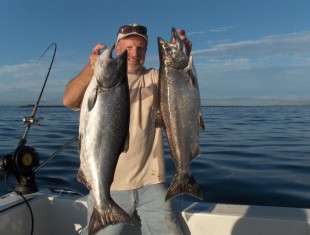Earl Sande
For me, the end of summer means I’ll soon smell the wonderful aroma of chanterelle mushrooms cooking in the frying pan.
My first memory of that delicious odor was in the fall of 1962. As a young boy growing up near Tahuya I was lucky enough to have a grandfather (Cecil Baldwin) who loved taking us kids hunting and fishing with him even if it made that task a little bit more difficult.
That September Day we were driving the old logging roads above Tahuya looking for grouse for dinner. There were lots of blue grouse then, but it was nothing like the late 1940s and 1950s when flocks of 50 still existed.
Fried grouse and chanterelles make an unbelievable meal and that day we were successful at both. I can still remember the smell of that dinner and have been hooked on chanterelles ever since.
Chanterelles belong to a group of fungi called Basidiomycetes that branched off from other fungi about one billion years ago. That was nearly 400 million years before plants evolved.
Basidiomycete fungi evolved to rely on tree roots for much of their nutrients about 200 million years ago when white pines first appeared on earth. The fungi also absorb water and minerals from the ground sending it to the tree roots though their many tiny roots, which was a great benefit to the trees.
Chanterelles haven’t changed much in the last 100 million years. They can be found on every continent except Antarctica, but who knows, maybe there are chanterelles spores under the ice?
The Chinese had been eating mushrooms for over 6,000 years and had written a reference guide showing edible and non-edible mushrooms eight hundred years ago. They have also used chanterelles for medicine over thousands of years for night blindness, dry skin and other medical problems.
The first to mention chanterelles in European literature was a guy named Lobelius in 1581 who was a Dutch herbalist.
Hundreds of years ago many Germanic and Anglo-Saxon Europeans were considered mycophobic, which means afraid of fungi or eating mushrooms, while people of Slavic, Finnish and humans that lived around the Mediterranean were considered mycophilic, which means they were fond of eating fungi.
Written history tells us the Romans were eating chanterelles over two thousand years ago.
It also became fashionable for wealthy Britons to serve chanterelles at fancy parties in the late 1800s.
Over 40 species of chanterelles and chanterelles-like mushrooms can be found in North American forests and most are edible. They don’t rely on the sun as other plants do; they absorb minerals from the forest floor but get their carbohydrates from tree roots, so no trees no chanterelles, plain and simple. Clear-cuts can wipe them out for 20 years or more.
Their abundance in Europe has been in steep decline for 30 years because of air pollution, short timber rotations, clear-cutting, depletion of forest soil litter layers and excessive mushroom harvesting.
The two most commercially valuable and widely collected Pacific Northwest chanterelles are the Pacific golden and the white variety. About 30 years ago the export market developed for northwest chanterelles and some people thought that would be the end of them. But they seemed to survive, especially when people discovered that nobody was going to get rich picking mushrooms.
Managing for a healthy forest is the answer for healthy chanterelle production. Retail prices vary around the world. Chanterelles have sold for 100 dollars a pound in Japan, $22 a pound in Dallas, $10 in San Francisco, $5 in Belfair and one dollar a pound in Africa.
Most of the chanterelle lives underground and consists of hundreds of long one-cell-wide fungal filaments, many of which are attached to very tiny tree roots exchanging water and minerals for the benefit of both.
The fruit part that pops up above the ground during late summer and fall is mainly for reproducing, sending off tiny spores that will hopefully help expand the mushroom patch.
Under the right conditions the fruit can stay in good shape for 90 days, but usually much shorter.
Our Pacific golden chanterelles grow best in a 40-year-plus fir and hemlock forest with well-drained soil with low nitrogen content and a pH range of 4.0 to 5.5. Adding nitrogen fertilizer to the forest floor is very bad for chanterelles.
Abundance varies from year to year and usually has something to do with the weather, a warm summer with some late summer rain and a little rain through the fall is about as good as it gets.
Our chanterelles are rarely eaten or infected by insects compared to other mushrooms. They seem to have evolved with a natural pesticide that protects them.
Also, our wildlife rarely eats them, but animals often eat chanterelles in Europe.
The health benefits of eating chanterelles are probably more then we know, but this is no junk food! They protect us from many types of cancer and bad bacteria.
Eating them also increases the resistance of certain diseases of the respiratory tract. These mushrooms are also very high in vitamin A and contain very high levels of vitamin D, plus are high in antioxidants.
In the last 25 years some major chanterelle studies have taught us a few things. Harvesting chanterelles does not necessarily mean there will be less mushrooms the next year or years after that. But eventually it could.
And is it better to pluck or cut when harvesting?
One 15-year study showed that plucking them from the ground increased next year’s production, and cutting off the stem lessoned future production. But another study showed that if you cut the stem then covered the hole with dirt and moss to help keep damaging bacteria away, future harvest was good.
There has been some success in Europe planting chanterelles by getting tiny roots to attach to the roots of small pine trees, then planting a new forest or planting the small pines in a forest. I haven’t heard of much success in the northwest though.
Harvesting chanterelles and eating them is a ton of fun, but there are similar looking mushrooms that can kill you so you really need to know what you are doing.
Plus, trespassing on some one’s private property without permission is against the law.


